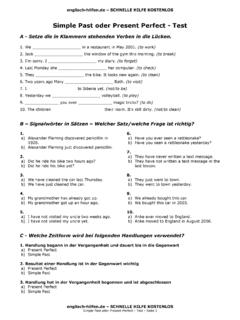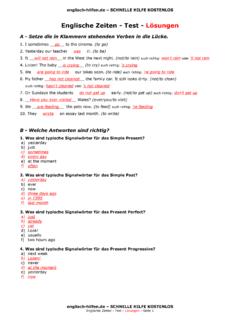Transcription of A SELF INSTRUCTIONAL COURSE - kannada …
1 P q KANNADAA self INSTRUCTIONAL COURSELINGADEVARU HALEMANEKARNATAKA GOVERNMENTKANNADA DEVELOPMENT AUTHORITYBENGALURUCzs P g i v `P q dU v ' P q r P t P z v v EA z Vz . F r zs i v s U q d g z q i tz z g . C g g P rU g DVz g A z A P . C g i v s U z ; Dz g F z C -D Ai q z , E Ai g - z I t Aq P rU A U P V g Ai P , E Ai s Ai Z V P v P rU g w- P s d g U P JA z P q C P g z D Ai Vz.
2 F Ai g v g w g U Ax z . || AU z g Ai g F Az s z U g Az z U Ai v . C g EAV P C Eg j j , v U , v , Ai i A v i g p s U U C z . F C z Q Ai Ai P V q || , || Ad Aq , || P Am g v || .Z U C g D Q Az v q V P Aq P j z P g P Ai Vz . || AU z g v C P l j z J z A jU P g I t Ai i Vz .P lP z z P P Aq P Aq g q U s P g P q Z V P v , P q A wAi Cx i rP Aq P rU g g Ai z P F U Ax g U z JA P g z Vz.
3 F U Ax P lu Ai g u P q C P g z Czs P g z || g U g g Z Az g z . C g C Ai Dg A s z z t Q Ai i . C g C P g Ai Nz U g P U s V FU g Ai z t zs U w z . || g U g v i E C g F Az s z P v d v U A U Ai v .F P z v w Ai z tz Az s z D Q Az v q V P Aq P g z P Ai z U z q || g zs g P . U J A U P P v d v U . kannada : A self INSTRUCTIONAL COURSE by Lingadevaru Halemane Published by kannada Development Authority Govt.
4 Of KarnatakaPages : 259 + 16 First Edition:1989 Second Edition:2003 Third Edition:2012 x z t :1989 w Ai z t :2003v w Ai z t :2012 :35-00 g U Price:Rs. 35/- P P g :P q C P g zs zs , P lP P g AU g Printer :Karnataka Offset Printers 30/2, 4th Main, 3rd Cross,Chamarajpet, Bangalore-18. (: 26678525q . R Aw Z Az Czs P g AU g AP : 1-12-2012P q C P g , AU g Czs P g q . R Aw Z Az P Ai z q . P . g zs g INTRODUCTIONThis is a self - INSTRUCTIONAL material prepared to develop speaking, reading and writing skills.)
5 This is intended for adult English Learners from different mother-tongue backgrounds, who wants to learn kannada for various is hoped that this self INSTRUCTIONAL material would enable the learner to construct orally the basic sentences with the help of given patterns and lexical items. This would also enable the learner to converse with the native speakers in given situation with the help of conversations framed. The book also takes care of the skills of reading and attempt has been made here to present the material as systematically as possible. The language and the situations used to follow the principle of selection and gradation which is the modern practice the world over.
6 The lessons show development from the simple to the complex and from the known to the unknown. Provision has been made for reinforcement of the language habits through conversation and narration. The language structures introduced here are found in informal spoken contexts and their description in the text are pedagogically book contains two parts. Part I deals with graded language structuring and Part II deals with the I contains 25 lessons. These lessons are structurally graded. The language used in these lessons is standard spoken kannada . The Bangalore - Mysore dialect of kannada is generally accepted as the standard spoken kannada .
7 However one can see certain changes at phonological level, like dropping of the vowel in the second syllable in the spoken form. One can find occassional overlapping of formal and informal usage in this basic lesson contains five components, namely, conversation/narration, pattern drill, key to learners, exercise and lesson is a running conversation/narration written on a specific situation with appropriate structure and vocabulary. The purpose of having a majority of the lesson in the form of conversation is that it forms the 'stimulus-reponse pattern' in the learners. The dialogue form of the book facilitates participation by the learners with interchanging roles.
8 However the last four lessons are narrations; they can be used as reading texts. The content of the lessons include day to day social contexts and cultural information about Karnataka. The first ten lessons are given in Roman transliteration. A key to sound transcription is given in the begining of the book. The tenth lesson onwords, lessons are given in kannada Script. It is assumed by the time the learner completes the structure of first ten lessons that he would also have learnt the recognition of letters in isolation and in combination. the translation of text and pattern drill is given in English. (while the translations are largely idiomatically acceptable, the exigencies of instructions may have here and there resulted in slightly deviant English constructions).
9 Pattern drills and exercises are meant for reinforcement of the structures introduced in the lesson. Generally a distinction is made between drills and exercises on the lines of their nature. The drills aim at establishing the structure as habit. In other words they VI/Introductionestablish automatic response through intensive practice. Besides this they are also helpful in knowing the syntactic relationship among the related a true sense exercises are an application activity, No new structure is given under exercise. The learner is expected to apply the structure learnt in the lesson to test his vocabulary contains the newly introduced in the text as well as in the drill part under two headings, namely, vocabulary and supplementary vocabulary.
10 Vocabulary is listed in an alphabetical key to the learner gives a brief explanation of the structure or pattern introduced in the lesson. To a great extent extensive use of linguistic terminology is avoided. Necessary examples and sandhi rules are also II contains the introduction of the kannada alphabet. The letters have been introduced on their shape similarity and contrastive perception. This would enable the learner to recognise the letters in isolation and in combination as quickly as possible. The combination of consonants and vowels are also introduced on their shape similarity. The sound value in Roman script is also given along with the primary letters in order to enable the learner to identify the target language sounds.





